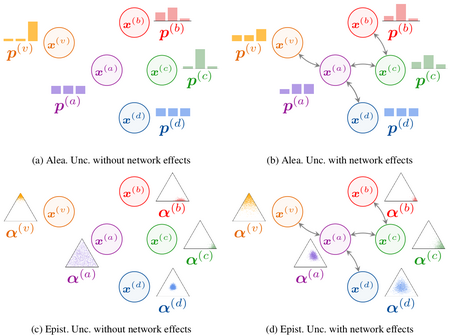This is the official code repository to the paper
Graph Posterior Network: Bayesian Predictive Uncertainty for Node Classification
Maximilian Stadler, Bertrand Charpentier, Simon Geisler, Daniel Zügner, Stephan Günnemann
Conference on Neural Information Processing Systems (NeurIPS) 2021.
We recommend running this code with its dependencies in a conda enviroment. To begin with, create a new conda environment with all the necessary dependencies assuming that you are in the root directory of this project:
conda env create -f gpn_environment.yml python==3.8 --forceSince the code is packaged, you will also have to setup the code accordingly. Assuming that you are in the root directory of this project, run:
conda activate gpn
pip3 install -e .Since we rely on published datasets from the Torch-Geometric package, you don't have to download datasets manually. When you run experiments on supported datasets, those will be downloaded and placed in the corresponding data directories. You can run the following datasets
- CoraML
- CiteSeer
- PubMed
- AmazonPhotos
- AmazonComputers
- CoauthorCS
- CoauthorPhysics
The experimental setup builds upon Sacred and configuring experiments in .yamlfiles. We will provide configurations
- for vanilla node classification
- leave-out-class experiments
- experiments with isolated node perturbations
- experiments for feature shifts
- experiments for edge shifts
with a default fraction of perturbed nodes of 10%. We provide them for the smaller datasets (i.e. all except ogbn-arxiv) for hidden dimensions H=10 and H=16.
The main experimental script is train_and_eval.py. Assuming that you are in the root directory of this project for all further commands, you can run experiments with
For the vanilla classification on the CoraML dataset with a hidden dimension of 16 or 10 respectively, run
python3 train_and_eval.py with configs/gpn/classification_gpn_16.yaml data.dataset=CoraML
python3 train_and_eval.py with configs/gpn/classification_gpn_10.yaml data.dataset=CoraML
If you have GPU-devices availale on your system, experiments will run on device 0 on default. If no CUDA-devices can be found, the code will revert back to running only on CPUs. Runs will produce assets per default. Also note that for running experiments for graphs under perturbations, you will have to run the corresponding vanilla classification experiment first.
We consider random features from Unit Gaussian Distribution (normal) and from a Bernoulli Distribution (bernoulli_0.5). When using the configuration ood_features, you can change those settings (key ood_perturbation_type) in the command line together with the fraction of perturbed nodes (key ood_budget_per_graph) or in the corresponding configurations files, for example as
python3 train_and_eval.py with configs/gpn/ood_features_gpn_16.yaml data.dataset=CoraML data.ood_perturbation_type=normal data.ood_budget_per_graph=0.025
python3 train_and_eval.py with configs/gpn/ood_features_gpn_16.yaml data.dataset=CoraML data.ood_perturbation_type=bernoulli_0.5 data.ood_budget_per_graph=0.025For experiments considering perturbations in an isolated fashion, this applies accordingly but without the fraction of perturbed nodes, e.g.
python3 train_and_eval.py with configs/gpn/ood_isolated_gpn_16.yaml data.dataset=CoraML data.ood_perturbation_type=normal
python3 train_and_eval.py with configs/gpn/ood_isolated_gpn_16.yaml data.dataset=CoraML data.ood_perturbation_type=bernoulli_0.5We consider random edge perturbations and the global and untargeted DICE attack. Those attacks can be set with the key ood_type which can be either set to random_attack_dice or random_edge_perturbations. As above, those settings can be changed in the command line or in the corresponding configuration files. While the key ood_budget_per_graph refers to the fraction of perturbed nodes in the paragraph above, it describes the fraction of perturbed edges in this case.
python3 train_and_eval.py with configs/gpn/ood_features_gpn_16.yaml data.dataset=CoraML data.ood_type=random_attack_dice data.ood_budget_per_graph=0.025
python3 train_and_eval.py with configs/gpn/ood_features_gpn_16.yaml data.dataset=CoraML data.ood_type=random_edge_perturbations data.ood_budget_per_graph=0.025With the settings above, you can reproduce our experimental results. If you want to change different architectural settings, simply change the corresponding keys in the configuration files with most of them being self-explanatory.
If you want to have a detailed look at our code, we give a brief overview of our code structure.
configs: directory for model configurationsdata: directory for datasetsgpn: source codegpn.data: code related to loading datasets and creating ID and OOD datasetsgpn.distributions: code related to custom distributions similar to torch.distributionsexperiments: main routines for running experiments, i.e. loading configs, setting up datasets and models, training and evaluationgpn.layers: custom layersgpn.models: implementation of reference models and Graph Posterior Network (+ablated models)gpn.nn: training related utilities like losses, metrics, or training enginesgpn.utils: general utility code
saved_experiments: directory for saved modelstrain_and_eval.py: main script for training & evaluationgpn_qualitative_evaluation.ipynb: jupyter notebook which evaluates the results from Graph Posterior Network in a qualitative fashion
Note that we provide the implementations of most of our used reference models. Our main Graph Posterior Network model can be found in gpn.models.gpn_base.py. Ablated models can be found in a similar fashion, i.e. PostNet in gpn.models.gpn_postnet.py, PostNet+diffusion in gpn.models.gpn_postnet_diff.py and the model diffusiong log-beta scores in gpn.models.gpn_log_beta.py.
We provide all basic configurations for reference models in configs/reference. Note that some models have dependencies with others, e.g. running classification_gcn_dropout.yaml or classification_gcn_energy.yaml would require training the underlying GCN first by running classification_gcn.yaml first, running classification_gcn_ensemble.yaml would require training 10 GCNs first with init_no in 1...10, and running classification_sgcn.yaml (GKDE-GCN) would require training the teacher-GCN first by running classification_gcn.yaml and computing the kernel values by running classification_gdk.yaml first.
Please cite our paper if you use the model or this code in your own work.
@incollection{graph-postnet,
title={Graph Posterior Network: Bayesian Predictive Uncertainty for Node Classification},
author={Stadler, Maximilian and Charpentier, Bertrand and Geisler, Simon and Z{\"u}gner, Daniel and G{\"u}nnemann, Stephan},
booktitle = {Advances in Neural Information Processing Systems},
volume = {34},
publisher = {Curran Associates, Inc.},
year = {2021}
}
